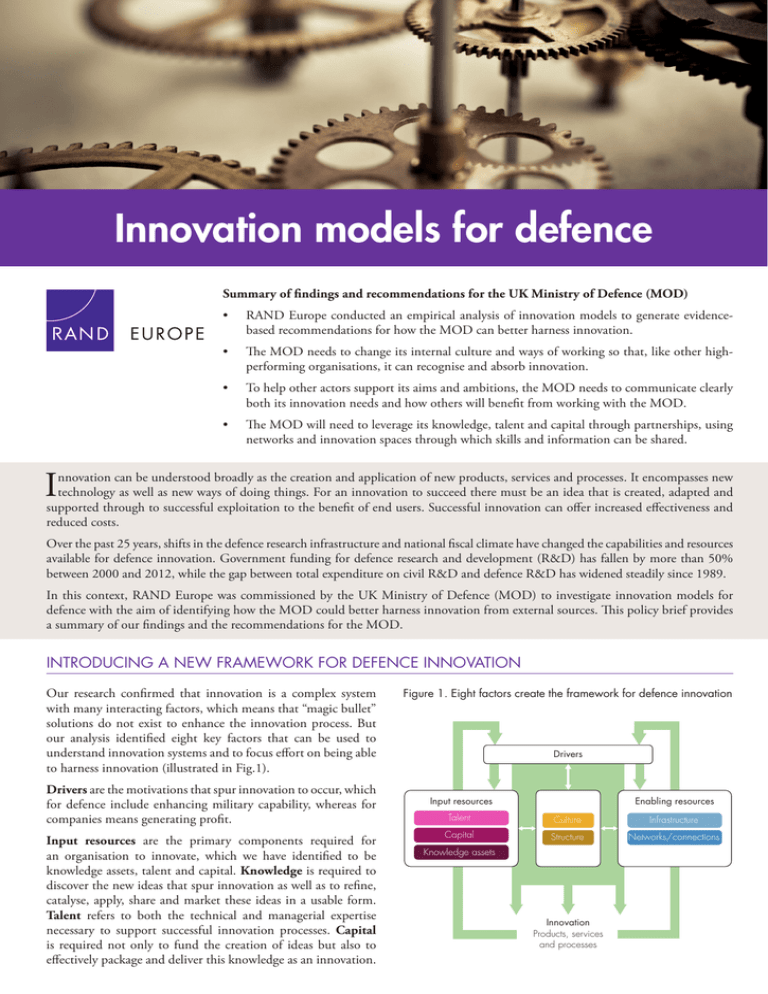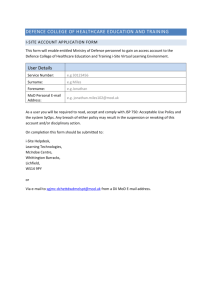Innovation models for defence
advertisement

Innovation models for defence Summary of findings and recommendations for the UK Ministry of Defence (MOD) • RAND Europe conducted an empirical analysis of innovation models to generate evidencebased recommendations for how the MOD can better harness innovation. • The MOD needs to change its internal culture and ways of working so that, like other highperforming organisations, it can recognise and absorb innovation. • To help other actors support its aims and ambitions, the MOD needs to communicate clearly both its innovation needs and how others will benefit from working with the MOD. • The MOD will need to leverage its knowledge, talent and capital through partnerships, using networks and innovation spaces through which skills and information can be shared. I nnovation can be understood broadly as the creation and application of new products, services and processes. It encompasses new technology as well as new ways of doing things. For an innovation to succeed there must be an idea that is created, adapted and supported through to successful exploitation to the benefit of end users. Successful innovation can offer increased effectiveness and reduced costs. Over the past 25 years, shifts in the defence research infrastructure and national fiscal climate have changed the capabilities and resources available for defence innovation. Government funding for defence research and development (R&D) has fallen by more than 50% between 2000 and 2012, while the gap between total expenditure on civil R&D and defence R&D has widened steadily since 1989. In this context, RAND Europe was commissioned by the UK Ministry of Defence (MOD) to investigate innovation models for defence with the aim of identifying how the MOD could better harness innovation from external sources. This policy brief provides a summary of our findings and the recommendations for the MOD. INTRODUCING A NEW FRAMEWORK FOR DEFENCE INNOVATION Our research confirmed that innovation is a complex system with many interacting factors, which means that “magic bullet” solutions do not exist to enhance the innovation process. But our analysis identified eight key factors that can be used to understand innovation systems and to focus effort on being able to harness innovation (illustrated in Fig.1). Drivers are the motivations that spur innovation to occur, which for defence include enhancing military capability, whereas for companies means generating profit. Input resources are the primary components required for an organisation to innovate, which we have identified to be knowledge assets, talent and capital. Knowledge is required to discover the new ideas that spur innovation as well as to refine, catalyse, apply, share and market these ideas in a usable form. Talent refers to both the technical and managerial expertise necessary to support successful innovation processes. Capital is required not only to fund the creation of ideas but also to effectively package and deliver this knowledge as an innovation. Figure 1. Eight factors create the framework for defence innovation Drivers Input resources Enabling resources Talent Culture Infrastructure Capital Structure Networks/connections Knowledge assets Innovation Products, services and processes Enabling resources, such as infrastructure and networks and connections, allow an organisation to bolster its knowledge assets, talent and capital through engagement with other actors. Infrastructure includes facilities and research hubs that provide a physical space for innovation, such as government labs, universities, science parks and test facilities. Networks and connections encourage the exchange of knowledge, the mingling of talented individuals and the connection of suppliers to end users. Innovation thrives in organisations with a culture that is open, trusting, and conducive to risk-taking and learning from failure rather than avoiding it. A supportive culture of innovation is often linked to leadership that is future-oriented and willing to support creative solutions. Closely linked with culture is structure, which includes organisational, management and bureaucratic structures. Bureaucracy and formal rules may act to constrain innovation by restricting knowledge exchange or productive partnerships. FINDINGS We considered options to improve performance against each of the factors of our innovation framework and concluded there are four main areas of the defence innovation system that should be addressed in order to develop a comprehensive and effective innovation model (Fig. 2). As a starting point, changes must be made to the ways of working within the MOD itself; without an internal environment that is conducive to innovation, new opportunities for collaboration will be ineffectively exploited. At the same time, external actors must be incentivised and able to participate in innovation with and for the MOD. Once both internal and external players are open to engaging on innovation, it becomes necessary to improve the ways in which their connection occurs. The dynamics of interactions Figure 2. Four areas of the defence system to be addressed Space for innovation to emerge An open innovation culture within the MOD Effective and diverse networks and interactions External actors who are empowered and motivated to engage should thus be adapted to encourage a range of engagement mechanisms. At the same time, new space should be available for diverse actors to come together and develop new solutions. RECOMMENDATIONS We recommend four thematic levels of change that the MOD should undertake to harness innovation: • The MOD must change its culture and ways of working to position it to recognise and absorb innovation. • The MOD must communicate clearly its innovation needs to external actors and explain why it is worth their while to support defence needs. • The MOD should establish partnerships that go beyond customer–supplier relationships to leverage its knowledge, talent and capital. • The MOD should create spaces for innovation where inventors, investors and industry can partner with the MOD to leverage its resources The four recommendations can be pursued in a cumulative manner as ‘building blocks’ towards an effective innovation system, starting with basic internal changes to the MOD and eventually reaching more radical development of external shared spaces (Fig. 3). The cumulative direction suggested here is intended to produce the strongest foundation for a thriving MOD innovation model. Improving the dynamics of interaction, for example, will always be beneficial to the overall innovation process; however, if the MOD’s own environment is not ready to absorb the resultant innovation, or if external actors are not poised to participate in these relationships, the impact of this change will be limited. Furthermore, creating new networks and spaces for innovation will only yield the greatest benefit if it is clear to the wider innovation community what the MOD is seeking to achieve, and what the benefits are to them in taking part. We identify specific actions that could deliver against these recommendations: appointing a senior champion for internal change, preparing an innovation policy to communicate the MOD’s approach and needs, creating an honest broker to connect different actors across the innovation value chain, establishing innovation partnership centres at universities, and creating a defence openinnovation campus. We recommend detailed planning and costing of these options is initiated, drawing on existing examples of good practice both within and outside the MOD. Figure 3. Recommendations for change can be pursued in a cumulative manner Changing the location of innovation Changing the dynamics of interaction Stimulating external actors to work with the MOD Changing the internal MOD context This document is based on a study by RAND Europe documented in Innovation Models: Enabling new defence solutions and enhanced benefits from science and technology, by Jon Freeman, Tess Hellgren, Michele Mastroeni, Giacomo Persi Paoli, Kate Robertson, and James Black, RR-840-MOD, 2015 (available at www.rand.org/t/RR840), commissioned by the MOD through Dstl in April 2014. To view this brief online, visit www.rand.org/t/RB9808. RAND Europe is a not-for-profit research institute whose mission is to help improve policy and decisionmaking through research and analysis. RAND’s publications do not necessarily reflect the opinions of its research clients and sponsors. RAND® is a registered trademark. © Copyright 2015 RAND Corporation Limited Print and Electronic Distribution Rights: This document and trademark(s) contained herein are protected by law. This representation of RAND intellectual property is provided for noncommercial use only. Unauthorized posting of this publication online is prohibited. Permission is given to duplicate this document for personal use only, as long as it is unaltered and complete. Permission is required from RAND to reproduce, or reuse in another form, any of our research documents for commercial use. For information on reprint and linking permissions, please visit www. rand.org/pubs/permissions.html. WESTBROOK CENTRE MILTON ROAD CAMBRIDGE CB4 1YG UNITED KINGDOM TEL +44.1223.353.329 FAX +44.1223.358.845 RUE DE LA LOI, 82 1040 BRUSSELS BELGIUM TEL +32.2.669.2400 www.randeurope.org RB-9808-MOD






